The population of the world is growing but the number of people who work to grow the food needed to feed them is shrinking year by year. The labour shortage in agriculture has been a growing problem for several years, with the pool of unskilled labourers decreasing due to improved access to education and better job opportunities and inefficient seasonal worker visa programmes being unable to fulfil needs. Fruits and vegetables go unharvested or are discarded as the increase in farm labour expenses outweighs the potential revenue for crops.
Precision agriculture provides a solution to the needs of farm owners and workers, using Global Navigation Satellite Systems (GNSS) to make farms more efficient by automating the off-highway vehicles needed. GNSS positioning uses a constellation of satellites to determine an accurate position based on signals received from a piece of equipment and highly accurate time information. Machine control systems combine the use of GNSS receivers to provide the position of the machine; inertial navigation systems (INS) to bridge short gaps in GNSS availability and to provide the platform’s attitude (pitch, roll, and yaw); and a variety of other sensors to determine the movement of the machine’s attachments.
GNSS-based applications are used to support farm planning, field mapping, soil sampling, tractor guidance, and crop assessment, as farm implements can be guided in a manner that maximises efficiency and fills a gap in the labour supply. Automated machines can make work easier for operators, autonomous row-following and turning technology can reduce operator fatigue, enabling a longer day with less strain by following GNSS-guided paths. Soil-testing can also be automated. GNSS-integrated equipment can collect and label soil samples with RFID chips that store the GPS coordinates of each sample’s original location, ensuring that each sample is processed correctly every time. Machine control can automate physical tasks that previously required an operator to leave the cab to manhandle farm equipment, saving time and reducing the risk of injury to workers.
As well as helping combat the labour shortage and reducing safety risks to workers, machine control can help farmers unlock savings, sustainability, and market value while improving yields. Crop yield can be increased by using automated harvesters and transportation carts that reduce wastage and spillage, as well as increasing efficiency by saving time on manually loading storage carts. Precise application of scarce, costly, or environmentally risky products—seeds, water, and agrochemicals, such as fertilisers, herbicides, pesticides—can be done via automated machines, reducing wasteful application of these products, reducing environmental impact, and helping produce food at a lower cost. Variable rate technology (VRT) is a type of precision agriculture that applies the right number of seeds or amount of water or agrichemical at each point as the machinery moves across the field.
GNSS positioning, combined with other technology like sensors and radar, can be used for automated machine control in the practice of precision agriculture. This technology can be used to meet the demands of farmers who are facing a shrinking labour pool and increase crop yields, as well as reduce wastage of food and resources. To learn more about the future of automation of off-highway vehicles such as agricultural equipment, hear keynote speeches about the latest innovations in the field and visit a wide array of exhibitors, book your tickets to the DZOM EXPO taking place at the Donald E. Stephens Convention Centre in Chicago, IL, on December 3–4, 2024.
For more information, visit our website or email us at info@innovatrix.eu for the event agenda.
Read this article over on the Innovatrix blog and discover our other articles and events.


